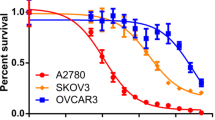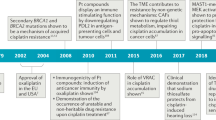Abstract
Oxaliplatin, the first available diaminocyclohexane platinum, has clinical activity in colorectal and ovarian cancers. Its mechanism of action is thought to be similar to that of cisplatin, its main mechanism being the intrastrand DNA adduct between two adjacent guanins or two adjacent guanine and adenine adducts. Ongoing molecular pharmacological studies of the mechanism of action of cisplatin suggest that platinated adducts are recognized by proteins of the mismatch repair system, including the products of the hMLH1 and hMSH2 genes. DNA mismatch repair defects occur in a wide variety of sporadic human cancers, are the main genetic factor in hereditary non-polyposis colon cancer and a frequent de novo or acquired phenomenon in ovarian cancer and other solid tumours. Moreover, they have recently been reported to be a cause of resistance to cisplatin but not to oxaliplatin, as diaminocyclohexane platinum adducts do not appear to be recognized by the mismatch repair complex. These findings explain the oxaliplatin activity in some cisplatin-resistant tumours. In addition, the good safety profile of oxaliplatin makes it a drug of choice for combination therapy, and it has been shown to be synergistic with other cytotoxic agents, including 5-fluorouracil, cisplatin, carboplatin, topotecan, gemcitabine and CPT-11. The results of several ongoing trials are awaited, but available data demonstrate that oxaliplatin is highly effective in the treatment of advanced colorectal and ovarian cancers. Promising early results suggest that it is also efficacious in non-Hodgkin's lymphoma, breast and non-small-cell lung cancers. As a result of its mechanism of action, its favourable safety profile and the differential profile of its antitumoral activity, the full potential of oxaliplatin as an active, versatile antitumoral agent is yet to be fully explored.
This is a preview of subscription content, access via your institution
Access options
Subscribe to this journal
Receive 24 print issues and online access
$259.00 per year
only $10.79 per issue
Buy this article
- Purchase on Springer Link
- Instant access to full article PDF
Prices may be subject to local taxes which are calculated during checkout
Similar content being viewed by others
Author information
Authors and Affiliations
Rights and permissions
About this article
Cite this article
Cvitkovic, E. Ongoing and unsaid on oxaliplatin: the hope. Br J Cancer 77 (Suppl 4), 8–11 (1998). https://doi.org/10.1038/bjc.1998.429
Issue Date:
DOI: https://doi.org/10.1038/bjc.1998.429
This article is cited by
-
Evaluation of survival benefits by platinums and taxanes for an unfavourable subset of carcinoma of unknown primary: a systematic review and meta-analysis
British Journal of Cancer (2013)
-
A phase I trial of oxaliplatin in combination with docetaxel in patients with advanced solid tumors
Cancer Chemotherapy and Pharmacology (2013)
-
Study of the synthesis, antiproliferative properties, and interaction with DNA and polynucleotides of cisplatin-like Pt(II) complexes containing carcinogenic polyaromatic amines
JBIC Journal of Biological Inorganic Chemistry (2013)
-
Retrospective analyses of cisplatin-based doublet combination chemotherapy in patients with advanced gastric cancer
BMC Cancer (2010)
-
Anti-tumor effects of CIK combined with oxaliplatin in human oxaliplatin-resistant gastric cancer cells in vivo and in vitro
Journal of Experimental & Clinical Cancer Research (2010)



